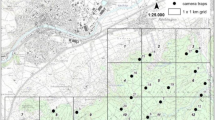Abstract
Predation hazard is one of the most important factors that affect foraging behavior. Light intensity is an indirect measure of a predation hazard for nocturnal rodents. In 1988 and 1989, I conducted laboratory experiments to reveal the effects of the predation hazard on foraging behavior of two species of field mice,Apodemus speciosus Temminck andA. argenteus Temminck (Rodentia: Muridae), which co-exist in many areas in Japan. I released a mouse into the experimental arena, where I set one nest box and two food stations (one near and the other far from the nest box), and recorded the foraging behavior for sixA. speciosus and sixA. argenteus mice. I planned to illuminate the experimental arena when the mouse left the nest box to mimic a predation hazard during excursion. The light treatment decreased the time the mouse spend outside the nest box, the duration of an excursion, the number of visits to the food station far from the nest box, and the number of peanuts handled at the food station far away. Mice handled food more intensely at the food station near to the nest box and tended to carry more foods back to the nest box and eat them there during the light treatment period than the control period. These behavioral changes, which seemed to be adaptive to avoid the predation hazard in the field, were more apparent in smaller mice,A. argenteus, than larger mice,A. speciosus.
Similar content being viewed by others
Literature cited
Brown, J.S., Kotler, B.P., Smith, J.R., and Wirtz II, W.O. (1988) The effects of owl predation on the foraging behavior of heteromyid rodents. Oecologia 76: 408–415
Clark, B.K. and Kaufman, D.W. (1991) Effects of plant litter on foraging and nesting behavior of prairie rodents. J. Mammal. 72: 502–512.
Clarke, J.A. (1983) Moonlight’s influence on predator/prey interactions between short-eared owls (Asio flamineus) and deer mice (Peromyscus maniculatus). Behav. Ecol. Sociobiol. 13: 205–209.
Daly, M., Wilson, M.I., Behrends, P.R., and Jacobs, L.F. (1992) Characteristics of kangaroo rats,Dipodomys merriani, associated with different predation risk. Anim. Behav. 40: 380–389.
Doi, T. and Iwamoto, T. (1982) Local distribution of two species ofApodemus in Kyushu. Res. Popul. Ecol. 24: 110–122.
Kotler, B.P. (1984a) Harvesting rates and predatory risk in desert rodents: A comparison of two communities on different continents. J. Mammal. 65: 91–96.
Kotler, B.P. (1984b) Risk of predation and the structure of desert rodent communities. Ecology 65: 689–701.
Kotler, B.P., Brown, J.S., and Hasson, O. (1991) Factors affecting gerbil foraging behavior and rate of owl predation. Ecology 72: 2249–2260.
Kotler, B.P., Brown, J.S., Smith, J.R., and Wirtz II, W.O. (1988) The effects of morphology and body size on rates of owl predation on desert rodents. Oikos 53: 145–152.
Lima, S.L. and Dill, L.M. (1990) Behavioral decisions made under the risk of predation: A review and prospects. Can. J. Zool. 68: 619–640.
Longland, W.S. and Price, M.V. (1991) Direct observations of owls and heteromyid rodents: Can predation risk explain microhabitat use? Ecology 72: 2261–2273.
Newman, J.A. and Caraco, T. (1987) Foraging, predation hazard and patch use in grey squirrels. Anim. Behav. 35: 1804–1813.
Newman, J.A., Recer, G.M., Zwicker, S.M., and Caraco, T. (1988) Effects of predation hazard on foraging “constraints”: Patch-use strategies in grey squirrels. Oikos 53: 93–97.
Nishimura, K. and Abe, M. (1988) Prey susceptibilities, prey utilization and variable attack efficiencies of Ural owls. Oecologia 77: 414–422.
Phelon, J.P. and Baker, R.H. (1992) Optimal foraging inPeromyscus polinotus: The influence of item-size and predation risk. Behaviour 121: 95–109.
Shioya, K., Shiraishi, S., and Uchida, T. (1990) Microhabitat segregation betweenApodemus argenteus andA. speciosus in northern Kyushu. J. Mammal. Soc. Jpn. 14: 105–118.
Author information
Authors and Affiliations
Corresponding author
About this article
Cite this article
Sone, K. Changes in foraging behavior of two species of field mice,Apodemus speciosus Temminck andA. argenteus Temminck (Rodentia: Muridae), in the response to artificial illumination. J For Res 7, 17–21 (2002). https://doi.org/10.1007/BF02762594
Accepted:
Issue Date:
DOI: https://doi.org/10.1007/BF02762594




